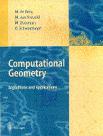

Fundamental techniques, data structures, and algorithms for solving geometric problems such as computing convex hulls, intersection of line segments, the Voronoi diagram and Delaunay triangulation of a point set, polygon triangulation, range search, linear programming, and point location. Some topics of discrete geometry, e.g., the crossing number of a graph and its applications, are also covered.
(09/FEB/15)
Mira composed a file with a few solved exam questions: click
here.
(29/DEC/14)
Janis: please send me an email message. Thanks! Gill
(29/DEC/14)
Ex3 was posted in the web page of the course.
(28/DEC/14)
There will be no tutorial on Monday 29/Dec/14.
(22/DEC/14)
Ex2 and Ex4 were posted in the web page of the course.
(10/DEC/14)
This is your chance to influence the day+time in which the course
Discrete Algorithmic Geometry (238739) will be given next semester!
Send me today by email your preferences and/or constraints.
(07/DEC/14)
There will be no tutorial on Monday 8/Dec/14.
(29/NOV/14)
There will be no tutorial on Monday 1/Dec/14.
(17/NOV/14)
- The tutorial of Monday, November 24, 2014, will be held.
- Mira's reception hour will be held on Mondays at 14:30.
- Home assignments should be submitted to Mira's email address
(mshalah@cs) or to her mailbox on floor 5.
(09/NOV/14)
There will be no recitation on Monday, November 10, 2014.
However, on Monday, November 17, 2014, the recitation will be held.
(02/NOV/14)
Correction:
There will be recitation on Monday, November 3, 2014.
(28/Oct/14)
Slides of all lectures and recitations are available below.
(23/Oct/14)
There will be no tutorial this Monday 27/Oct/14.
(23/Oct/14)
I brought the issue of the language, in which lectures will be given,
to the highest ranks in the faculty, namely the dean and three vice deans.
The conclusion was that the lectures will be given in English IF there
are non-English speakers in the audience, and Hebrew support (that is,
translation to Hebrew) will be given upon request.
(20/Sep/14) All students (including free listeners) are kindly requested to join the mailing list of the course. (This is in addition to the formal registration to the course! One can leave this mailing list at any time.) For joining the mailing list, please e-mail me (barequet@cs) your full name, id #, faculty, and degree toward which you study.
 |
Main text book: Computational Geometry: Algorithms and Applications (3rd ed.), M. de Berg, M. van Kreveld, M. Overmars, and O. Schwarzkopf, Springer-Verlag, 2008. |
 |
For background: Computational Geometry in C (2nd ed.), J. O'Rourke, Cambridge University Press, 1998. |
3 Home assignments (dry): ~12.5% (Takef, submission in singletons!!);
Running project (wet): ~12.5% (same);
Final exam: 75% (1st term: Tuesday 17/Feb/15, time TBA, location TBA;
2nd term: Monday 16/Mar/15, hopefully no need to!)
Assignment 1 (dry): given 10/Nov/14, due 24/Nov/14.
Assignment 2 (dry): given 22/Dec/14, due 05/Jan/15.
Assignment 3 (dry): given ??/???/1?, due ??/???/1?.
Assignment 4 (wet): given 22/Dec/14, due 22/Jan/15 (Graphics files, FAQ file)